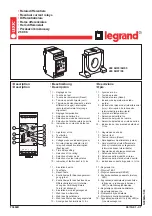
- 2 -
• Bei jedem Ein-Aus-Zyklus der Maschine
wird automatisch überprüft, ob die Relais
der Sicherheitseinrichtung richtig öffnen
und schließen.
• Der Trafo ist kurzschlussfest. Bei
Gleichspannung wirkt eine elektronische
Sicherung.
Funktionsbeschreibung
Das Schaltgerät PNOZ 16SP dient dem
sicherheitsgerichteten Unterbrechen eines
Sicherheitsstromkreises. Nach Anlegen der
Versorgungsspannung, bei gebrückten
Kontakten Y1-Y2 und S33-S34 sowie
geöffnetem Eingangskreis S11-S12 und/
oder S21-S22/S31-S32 (z. B. Not-Halt-
Taster betätigt) wird der Sicherheits-
schaltkreis vorbereitet und die LED
“POWER” leuchtet. Der Halbleiterausgang
Y35 ist im Normalbetrieb leitend.
• Eingangskreis geschlossen (z. B. Not-
Halt-Taster nicht betätigt): Relais K1 und
K2 gehen in Wirkstellung. Die Statusan-
zeigen “CH.1” und “CH.2” leuchten. Die
Sicherheitskontakte 13-14/23-24 sind
geschlossen. Der Halbleiterausgang Y32
ist leitend.
• Eingangskreis wird geöffnet (z. B. Not-
Halt-Taster betätigt): K1 und K2 fallen in
die Ruhestellung zurück. Die Sicherheits-
kontakte 13-14/23-24 werden redundant
geöffnet. Der Halbleiterausgang Y32
sperrt.
* Isolation zum nicht markierten Bereich und der
Relaiskontakte zueinander: Basisisolierung
(Überspannungskategorie III), sichere
Trennung (Überspannungskategorie II)
Betriebsarten:
• Einkanaliger Betrieb:
Eingangsbeschaltung nach VDE 0113
und EN 60204, keine Redundanz im
Eingangskreis; Erdschlüsse im Taster-
kreis werden erkannt.
• Zweikanaliger Betrieb: Redundanter
Eingangskreis; Erdschlüsse im Taster-
kreis und Querschlüsse zwischen den
Tasterkontakten werden erkannt.
• Automatischer Start: Gerät ist aktiv,
sobald der Eingangskreis geschlossen ist.
• Manueller Start: Gerät ist erst dann aktiv,
wenn ein Starttaster betätigt wird.
Function Description
The Relay PNOZ 16SP provides a single
fault safe output. When the operating
voltage is supplied, contacts Y1-Y2 and
S33-S34 are bridged and the input circuit
S11-S12 and/or S21-S22/S31-S32 is
opened (e.g. E-Stop Button activated), the
safety circuit is ready and the LED ‘POWER’
is illuminated. In normal operation, the
semiconductor output Y35 is held high.
• Input circuit closed (e.g. Emergency Stop
button activated): Relays K1 and K2
energise. The Status indicators ‘CH.1’
and ‘CH.2’ are illuminated. The safety
contacts 13-14/23-24 are closed. The
semiconductor output Y32 is held high.
• Input circuit opened (e.g. Emergency Stop
button activated): K1 and K2 de-
energise. The safety contacts 13-14/23-
24 are opened. The semiconductor output
Y32 is disabled.
* Insulation between the non-marked area
and the relay contacts: Basic insulation
(overvoltage category III), safe separation
(overvoltage category II)
Operating Modes:
• Single-channel operation: Input wiring
according to VDE 0113 and EN 60204, no
redundancy in the input circuit. Earth
faults are detected in the emergency stop
circuit.
• Two-channel operation: Redundancy in
the input circuit; Earth faults in the
emergency stop circuit and shorts across
the emergency stop pushbutton are
detected.
• Automatic reset: Unit is active, as soon
as the input circuit is closed.
Description du fonctionnement
Le bloc logique PNOZ 16SP assure de
façon sûre l'ouverture d'un circuit de
sécurité. Dès la mise sous tension du
relais, si les bornes Y1-Y2 et S33-S34 sont
pontées (circuits d’entrées S11-S12 et/ou
S21-S22, S31-32 ouverts), la logique
interne du relais est activée et la LED
"POWER" s’allume. La sortie statique Y35
est passante en fonctionnement normal.
• Circuit d'entrée fermé (par ex. poussoir
AU non actionné): les relais K1 et K2
passent en position travail et s'auto-
maintiennent. Les contacts de sécurité
(13-14/23-24) se ferment. Les LEDs
"CH.1” et “CH.2" sont allumées. La sortie
statique Y32 est passante.
• Circuit d'entrée ouvert (par ex. poussoir
AU actionné): K1 et K2 retombent. Les
contacts de sécurité (13-14/23-24)
s'ouvrent de façon redondante. Les LED
"K1”et “K2" s'éteignent. La sortie statique
Y32 est bloquée.
* Isolation de la partie non sélectionnée par
rapport aux contacts relais : isolation basique
(catégorie de surtensions III), isolation
galvanique (catégorie de surtensions II)
Mode de fonctionnements:
• Commande par 1 canal: conforme aux
prescriptions de la norme EN 60204, pas
de redondance dans le circuit d'entrée.La
mise à la terre du circuit d'entrée est
détectée.
• Commande par 2 canaux: circuit d’entrée
redondant. La mise à la terre et les
courts-circuits entre les contacts sont
détectés.
• Réarmement automatique: le relais est
activé dès la fermeture des canaux
d’entrée.
Fig. 1: Innenschaltbild/Internal Wiring Diagram/Schéma de principe
S12
13 23
14 24
Y2
S11
S32
S31
S33
K2
K1
Y1
Y31
Y32
Y30
~
=
G1
F1
A1 A2
&
Y35
B1 B2
S21 S22
S34
A
1
2
*
A: Einschaltlogik, zyklscher Test, Steuerlogik
1: Kanal 1
2: Kanal 2
A: Operating Logic, Cycle Test, Control Logic
1: Channel 1
2: Channel 2
A: logique de commande et d’entrée,
test cyclique
1 : canal 1
2 : canal 2
• The correct opening and closing of the
safety function relays is tested
automatically in each on-off cycle.
• The transformer is short-circuit proof.
DC Units are fitted with an electronic fuse.
• transfomateur d’alimentation protégé
contre les courts-circuits. Protection par
fusible électronique pour les appareils
alimentés en continu.



































